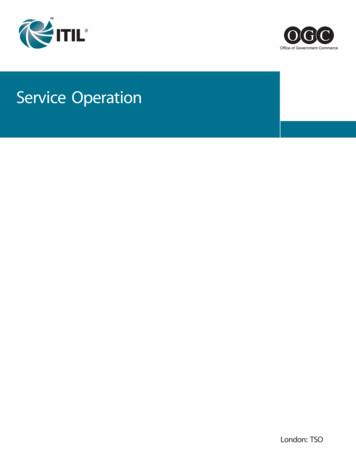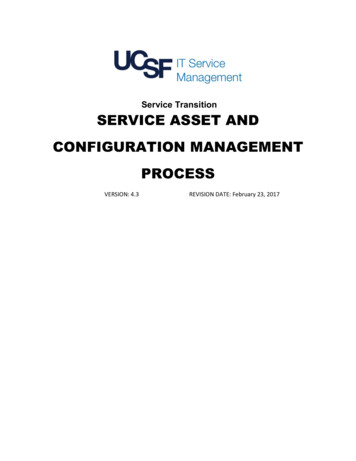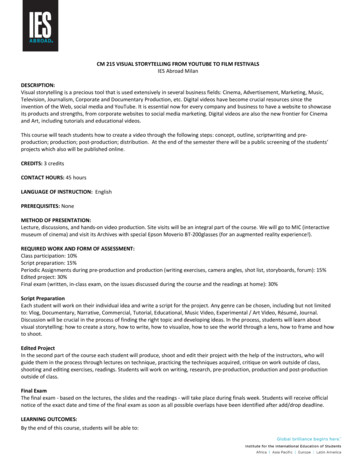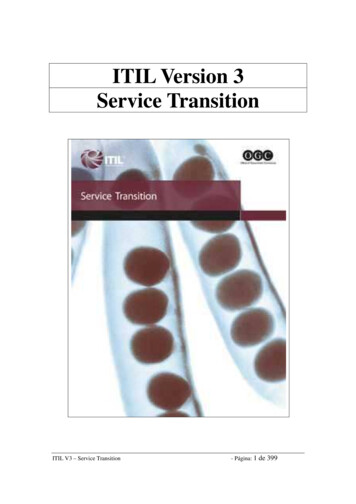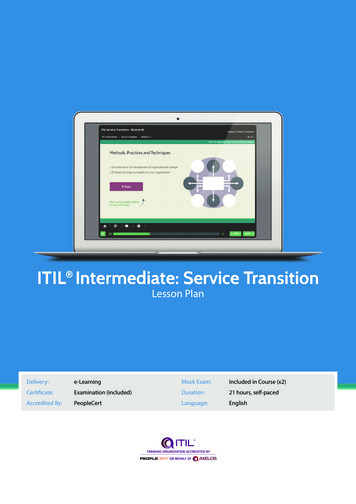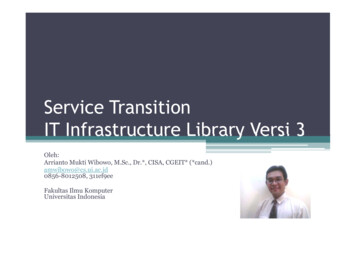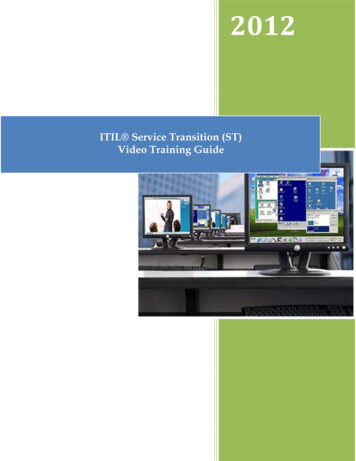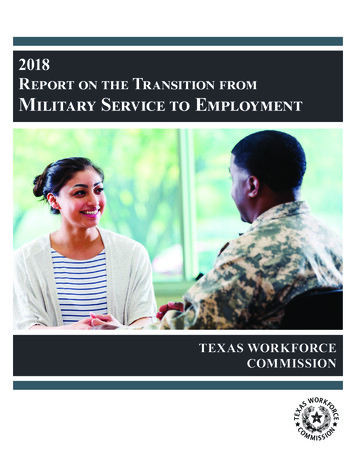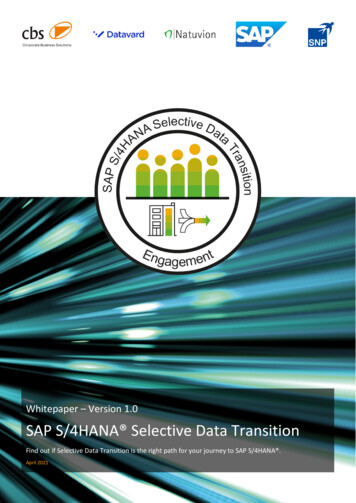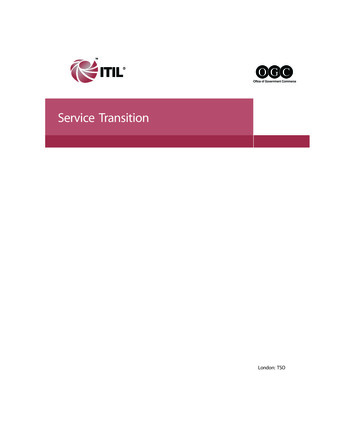
Transcription
01-ITIL Service Transition21/5/0712:45Page iService TransitionLondon: TSO
01-ITIL Service Transition21/5/0712:45Page iiPublished by TSO (The Stationery Office) and available from:Onlinewww.tsoshop.co.ukMail,Telephone, Fax & E-mailTSOPO Box 29, Norwich, NR3 1GNTelephone orders/General enquiries: 0870 600 5522Fax orders: 0870 600 5533E-mail: customer.services@tso.co.ukTextphone 0870 240 3701TSO Shops123 Kingsway, London,WC2B 6PQ020 7242 6393 Fax 020 7242 639416 Arthur Street, Belfast BT1 4GD028 9023 8451 Fax 028 9023 540171 Lothian Road, Edinburgh EH3 9AZ0870 606 5566 Fax 0870 606 5588TSO@Blackwell and other Accredited AgentsPublished for the Office of Government Commerce under licence from theController of Her Majesty’s Stationery Office. Crown Copyright 2007This is a Crown copyright value added product, reuse of which requires a Click-Use Licence for valueadded material issued by OPSI.Applications to reuse, reproduce or republish material in this publication should be sent to OPSI,Information Policy Team, St Clements House, 2-16 Colegate, Norwich, NR3 1BQ, Tel No (01603) 621000Fax No (01630) 723000, E-mail: hmsolicensing@cabinet-office.x.gsi.gov.uk, or complete the applicationform on the OPSI website ce-information/index.htmOPSI, in consultation with Office of Government Commerce (OGC), may then prepare a Value AddedLicence based on standard terms tailored to your particular requirements including payment termsThe OGC logo is a Registered Trade Mark of the Office of Government CommerceITIL is a Registered Trade Mark, and a Registered Community Trade Mark of the Office of GovernmentCommerce, and is Registered in the U.S. Patent and Trademark OfficeThe Swirl logo is a Trade Mark of the Office of Government CommerceFirst published 2007ISBN 978 0 11 331048 7Printed in the United Kingdom for The Stationery Office
01-ITIL Service Transition21/5/0712:45Page iiiiii ContentsList of figuresvList of tablesviiOGC’s forewordviii5.25.36Managing organization and stakeholderchange161Stakeholder management173Organizing for Service Transition177Chief Architect’s forewordix6.1Generic roles179Prefacexi6.2Organizational context for transitioninga service179Acknowledgementsxii6.3Organization models to supportService Transition181Service Transition relationship withother lifecycle Goal and scope of Service Transition71.4Usage7Service Management as a practice34What is Service Management?132.2What are services?132.3Functions and processes across thelifecycle14Service Transition fundamentals16Service Transition principles2158Technology considerationsPrinciples supporting Service Transition233.2Policies for Service Transition243391917.1Knowledge management tools1937.2Collaboration1947.3Configuration Management system194Implementing Service Transition8.13.1Service Transition processes7112.12.46.4197Stages of introducing Service Transition199Challenges, critical success factorsand risks2039.1Challenges2059.2Critical success factors2059.3Risks2069.4Service Transition under difficult conditions206Afterword20942Appendix A: Description of asset types213Service asset and configurationmanagement65Further information2174.4Release and deployment management844.5Service validation and testing1154.6Evaluation1384.7Knowledge management1454.1Transition planning and support354.2Change Management4.3Service Transition common operationactivities1555.1Managing communications andcommitment157ReferencesGlossary219221Acronyms list223Definitions list225Index251
01-ITIL Service Transitioniv21/5/0712:45Page iv List of figuresAll diagrams in this publication are intended to provide anillustration of ITIL Service Management Practice conceptsand guidance. They have been artistically rendered tovisually reinforce key concepts and are not intended tomeet a formal method or standard of technical drawing.The ITIL Service Management Practices Intergrated ServiceModel conforms to technical drawing standards andshould be referred to for complete details. Please seewww.best-management-practice.com/itil for details.Figure 4.11 (b) Example configuration breakdown for aManaged Virtual SystemFigure 1.1Sourcing of Service Management practiceFigure 1.2ITIL CoreFigure 4.15 Simplified example of release units for an ITserviceFigure 2.1A conversation about the definition andmeaning of servicesFigure 4.12 Example of service lifecycle configurationlevels and baseline points, represented by thenumbered trianglesFigure 4.13 Simplified example of an IT infrastructureFigure 4.14 Example of asset and configuration itemlifecycleFigure 4.16 Options for ‘big bang’ and phased rolloutFigure 2.2A basic processFigure 4.17 Phased deployment across geographicallocationsFigure 2.3The scope of Service TransitionFigure 4.18 Architecture elements to be built and testedFigure 3.1Service assets required to deliver services tothe businessFigure 4.19 Example of a release packageFigure 3.2Services provide value by increasing theperformance of customer assets andremoving risksFigure 4.20 Coordinating the deployment of servicecomponentsFigure 4.21 Service V-model to represent configurationlevels and testingFigure 4.1Scope of change and release management forservicesFigure 4.22 Example of service testing through ServiceTransitionFigure 4.2Example process flow for a normal changeFigure 4.23 Example of a set of deployment activitiesFigure 4.3Example process flow for standarddeployment requestFigure 4.24 Example of early life support activitiesFigure 4.4Example process flow for standard operationalchange requestFigure 4.5Example of a change authorization modelFigure 4.26 Service models describe the structure anddynamics of a serviceFigure 4.6Request for Change workflow and keyinterfaces to Configuration ManagementFigure 4.27 Dynamics of a service modelFigure 4.7Example of a logical configuration modelFigure 4.8Example of a Configuration ManagementSystemFigure 4.9The relationship between the Definitive MediaLibrary and the Configuration ManagementDatabaseFigure 4.25 Illustration of the benefits of targeted early lifesupportFigure 4.28 Design constraints of a serviceFigure 4.29 Value creation from service utilities andwarrantiesFigure 4.30 Example of service V-modelFigure 4.31 Designing tests to cover range of serviceassets, utilities and warrantiesFigure 4.10 Typical Configuration Management activitymodelFigure 4.32 Example of a validation and testing processFigure 4.11 (a) Example configuration breakdown for anend-user computing serviceFigure 4.34 Evaluation processFigure 4.33 Example of perform test activities
01-ITIL Service Transition21/5/0712:45Page v Figure 4.35 Example risk profileFigure 4.36 Context for qualification and validationactivitiesFigure 4.37 The flow from data to wisdomFigure 4.38 Relationship of the CMDB, the CMS and theSKMSFigure 4.39 Service knowledge management systemFigure 4.40 Contribution of knowledge to effectiveness ofsupport staffFigure 5.1Example of communications strategy and plancontentsFigure 5.2Example communication pathFigure 5.3Example of Service Transition steps foroutsourcingFigure 5.4The emotional cycle of changeFigure 5.5Potential stakeholdersFigure 5.6Example stakeholder mapFigure 5.7Power impact matrixFigure 5.8Example commitment planning chartFigure 6.1Example of Service Transition organizationand its interfacesFigure 6.2Organizational interfaces for a ServiceTransitionFigure 6.3Example of an organization for ServiceTransitionFigure 6.4Flow of experienceFigure 8.1Steps to improving Service Transitionprocessesv
01-ITIL Service Transitionvi21/5/0712:45Page vi List of tablesTable 4.1Example responsibility matrix for releasepoints during Service TransitionTable 4.2Extract from a service release policy for aretail organizationTable 4.3Example of types of request by servicelifecycle stageTable 4.4Example of contents of changedocumentationTable 4.5Example of a change impact and riskcategorization matrixTable 4.6Change priority examplesTable 4.7Configuration documentation for assets andresponsibilities through the service lifecycleTable 4.8Levels of configuration for build and testingTable 4.9Questions to be answered when planningdeploymentTable 4.10 Examples of service test modelsTable 4.11 Service requirements, 1: improve useraccessibility and usabilityTable 4.12 Examples of Service Managementmanageability testsTable 4.13 Key terms that apply to the service evaluationprocessTable 4.14 Factors for considering the effects of a servicechangeTable 5.1Job characteristics that motivate peopleTable 5.2Understanding the culture of the partiesinvolvedTable 5.3Example of RACI matrix for managing changeTable 5.4Example of organization work-products fromthe build stageTable 5.5Organizational role and skills assessmentchecklistTable 5.6Example of a feedback surveyTable 5.7Tips for managing changeTable 5.8J. P. Kotter’s ‘Eight steps to transforming yourorganization’
01-ITIL Service Transition21/5/0712:45Page vii OGC’s forewordSince its creation, ITIL has grown to become the mostwidely accepted approach to IT Service Management inthe world. However, along with this success comes theresponsibility to ensure that the guidance keeps pace witha changing global business environment. ServiceManagement requirements are inevitably shaped by thedevelopment of technology, revised business models andincreasing customer expectations. Our latest version of ITILhas been created in response to these developments.This publication is one of five core publications describingthe IT Service Management practices that make up ITIL.They are the result of a two-year project to review andupdate the guidance. The number of Service Managementprofessionals around the world who have helped todevelop the content of these publications is impressive.Their experience and knowledge have contributed to thecontent to bring you a consistent set of high-qualityguidance. This is supported by the ongoing developmentof a comprehensive qualifications scheme, along withaccredited training and consultancy.Whether you are part of a global company, a governmentdepartment or a small business, ITIL gives you access toworld-class Service Management expertise. Essentially, itputs IT services where they belong – at the heart ofsuccessful business operations.Peter FanningActing Chief ExecutiveOffice of Government Commercevii
01-ITIL Service Transitionviii21/5/0712:45Page viii Chief Architect’s forewordChief Architect’s forewordThis publication, ITIL Service Management PracticesService Transition, sits at the centre of the ITIL lifecyclestructure. Transition, is not an everyday word – words like‘design’ and ‘operate’, describing the lifecycle stages oneither side of transition, are more familiar. But these morefamiliar terms that bracket transition can also serve tohelp define and explain its goals and purpose.The need to design a service, totally new or changed, isaccepted – without a vision of the service’s purpose thatpurpose will always remain undelivered. And over the last17 years (since the inception of ITIL) the need has beenfirmly established for ongoing management of theservices. This has been recognized as the ‘core’ of ITService Management – providing and supporting the‘business as usual’ delivery of the organization’srequirements from IT.And so, it is readily apparent that successfully movingfrom the concept of ‘how’ – developed by design – into‘what’ – as supported by operations – is going to be thekey element of delivering the business support we arecharged with. And so there is always a need for a ServiceTransition.The importance of actually delivering a design, adapting itas needed, assuring and ensuring its continued relevance,has been less obvious to many. Service Transitionconcentrates on delivering the service vision in a relevantand cost-effective fashion. As such, Service Transition iseffectively defined by the service delivery concepts thatsupply its inputs and the Service Operations expectationsthat serve as recipients of its outputs – which are usableservices.The best way of achieving Service Transition will varybetween organizations and has to reflect the risks,resources and other parameters pertaining to thatorganization in general and the service to be transitionedin particular.A useful analogy is a relay race, where the team of runnersmust carry a baton round the track – passing it fromhand-to-hand between team members. The initialexpectation might be that victory in such a race relies onhaving the fastest athletes. However, important as speedand fitness of the runners are, it is equally important notto drop the baton. Conversely, total concentration oncareful and risk-free passing of the baton will also notmake a winning team. To win the race requires the rightcombination of speed and handover of the baton.In a similar way, Service Transition must deliver relevantservices with the appropriate balance of speed, cost andsafety.The priorities, concerns, constraints and conditions thatdictate the decisions and focus of Service Transition willvary between service providers. For those in safety-criticalindustries, such as medical technological support andnuclear power station control, the focus will be onthoroughness and risk reduction – the main priority here isnot to drop the baton: ‘take it carefully’ is the correctapproach. This is typical where competition is low, such asin the public sector, or where governmental controls insiston caution, or the customer perception of their reliabilityrequirement is high.Alternatively, in highly competitive industries, such asonline product sales or mobile telephone facilities, speedmay be more important. In a relay race with 100 teams,concentration on safe handover will bring you inconsistently in the first 20%, but you will probably neverwin. The customer’s business needs may dictate that itmakes more sense to drop the baton 80% of the time butcome first for the re
01-ITIL Service Transition 21/5/07 12:45 Page vi. OGC’s foreword Since its creation, ITIL has grown to become the most widely accepted approach to IT Service Management in the world. However, along with this success comes the responsibility to ensure that the guidance keeps pace with a changing global business environment. Service Management requirements are inevitably shaped by the .
